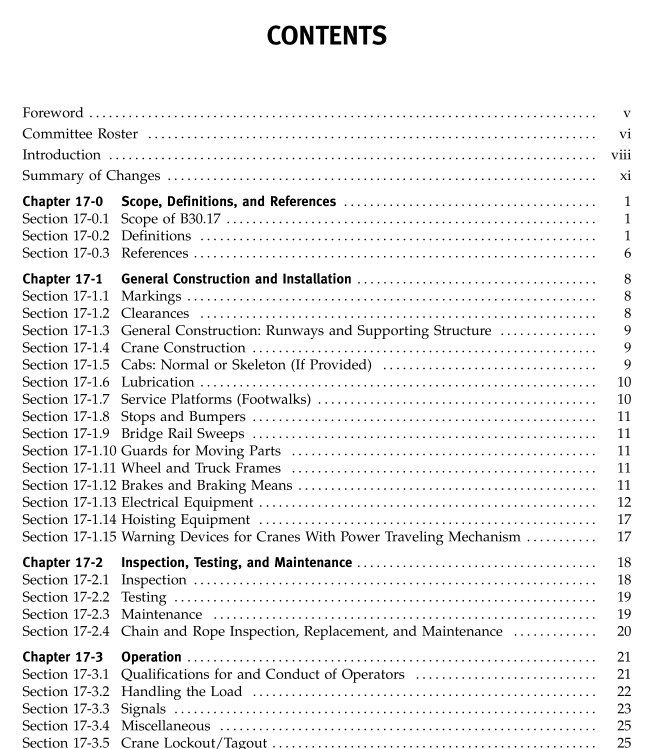ASME B30.17:2003 pdf free download OVERHEAD AND GANTRYCRANES (TOP RUNNING BRIDGE, SINGLEGIRDER, UNDERHUNG HOIST)
Section 17-0.1:scOPE OF B30.17
volume B30.17 includes provisions that apply to theconstruction,installation, operation, inspection, andmaintenance of hand-operated and power-driven over-head and gantry cranes that have a top-running single-girder bridge, with one or more underhung hoists (seeB30.16 Volume) operating on the lower flange of thebridge girder, used for vertical lifting and lowering offreely suspended, unguided loads (see Figs. 1 through5).The requirements included in this volume also applyto cranes having the same fundamental characteristicssuch as polar gantry cranes, cantilever gantry cranes,semi-gantry cranes, and wall cranes.
Requirements for a crane used for a special purposesuch as, but not limited to, non-vertical lifting service,lifting a guided load, or lifting personnel are notincluded in this volume.
Section 17-0.2:DEFINITIONs
abnormal operating conditions: environmental conditionsthat are unfavorable, harmful, or detrimental to or forthe operation of a crane,such as excessively high orlow ambient temperatures, exposure to adverse weather,corrosive fumes, dust-laden or moisture-laden atmo-spheres, and hazardous locations.
administrative or regulatory authority: governmentalagency, or the employer in the absence of governmentaljurisdiction.
appointed: assigned specific responsibilities by theemployer or the employer’s representative.
authorized: appointed by a duly constituted administra-tive or regulatory authority.
brake: a device, other than a motor, used for retardingor stopping motion by friction or power means.
braking , control: a method of controlling speed by remov-ing energy from the moving body or by impartingenergy in the opposite direction.
braking , countertorque (plugging): a method of controllingspeed by reversing the motor line voltage polarity orphase sequence to develop torque in the direction oppo-site to the rotation of the motor.
braking, dynanic: a method of controlling speed by usingthe motor as a generator, with the energy being dissi-pated in resistors.
braking , eddy current: a method of controlling or reducingspeed by means of an electrical induction load brake.braking , emergency: a method of decelerating a drivewhen power is not available.The braking effort maybe established as a result of action by the operator,orautomatically when power to the drive is interrupted.braking, hydraulic: a method of controlling or reducingspeed by means of displacement of a liquid.
braking means: a method or device used for stopping/holding motion by friction or power.
braking, mecharical: a method of controlling or reducingspeed by friction.
braking, pneumatic: a method of controlling or poweringa drive or brake by means of compressed gas.
braking, regenerative: a method of controlling speed inwhich the electrical energy generated by the motor isfed back into the power system.
braking,service: a method to decelerate crane motionduring normal operation.
bridge: the part of an overhead crane, consisting of onegirder, trucks, and (if applicable) drive mechanism, thatcarries the trolley or trolleys.
bridge girder: a crane member on which carriers or trol-leys travel horizontally, mounted between and sup-ported by the end trucks.
bridge travel: the crane movement in a direction parallelto the crane runway.
bumper (buffer): a device for reducing impact when amoving crane or trolley reaches the end of its permittedtravel,or when two moving cranes or trolleys come into contact. This device may be attached to the bridge,trolley, or runway stop.
cab: the operator’s compartment on a crane.
cab, skeleton: the operator’s compartment used for occa-sional cab operation of a normally floor- or remote-operated crane.
chain,hand: the chain grasped by the operator to applyforce required for lifting, lowering,or travelingmotions.1
chain,load: the load-bearing chain in a hoist.’
clearance: the distance from any part of the crane to thenearest obstruction.
collectors, cuerrent: contacting devices for conducting cur-rent from runway or bridge conductors.
conductors,bridge: the electrical conductors located alongthe bridge structure of a crane that transmit control sig-nals and power to the trolley(s).
conductors,r1Izway (main): the electrical conductors
located along a crane runway that transmit control sig-nals and power to the crane.
control panel: an assembly of components (magnetic,
static, hydraulic, pneumatic, etc.) that governs the flowof power to or from a motor or other equipment inresponse to signals from a master switch,push buttonstation, remote control, automatic program control, etc.controller: a device or group of devices that serves togovern, in a predetermined manner, the power delivereddirectly to the apparatus to which it is connected.
controller, maral: a controller having all of its basic func-tions performed by devices that are operated by hand.controller, sprig-return: a controller that, when released,will return automatically to a neutral (OFF) position.
crane: a machine for lifting and lowering a load, andmoving it horizontally. Cranes, whether fixed or mobile,
are driven manually, by power,or by a combinationof both.
crane, automatic: a crane that, when activated, operatesthrough a preset cycle or cycles.
crane,cab-operated: a crane whose movements are con-trolled by an operator through the use of controllerslocated in a cab that is attached to the crane (refer toFig. 1).
crane, cantileoer gantry: a gantry or semigantry crane inwhich the bridge girders or trusses extend transverselybeyond the crane runway on one or both sides (refer toFig.2).
ASME B30.17:2003 pdf free download
